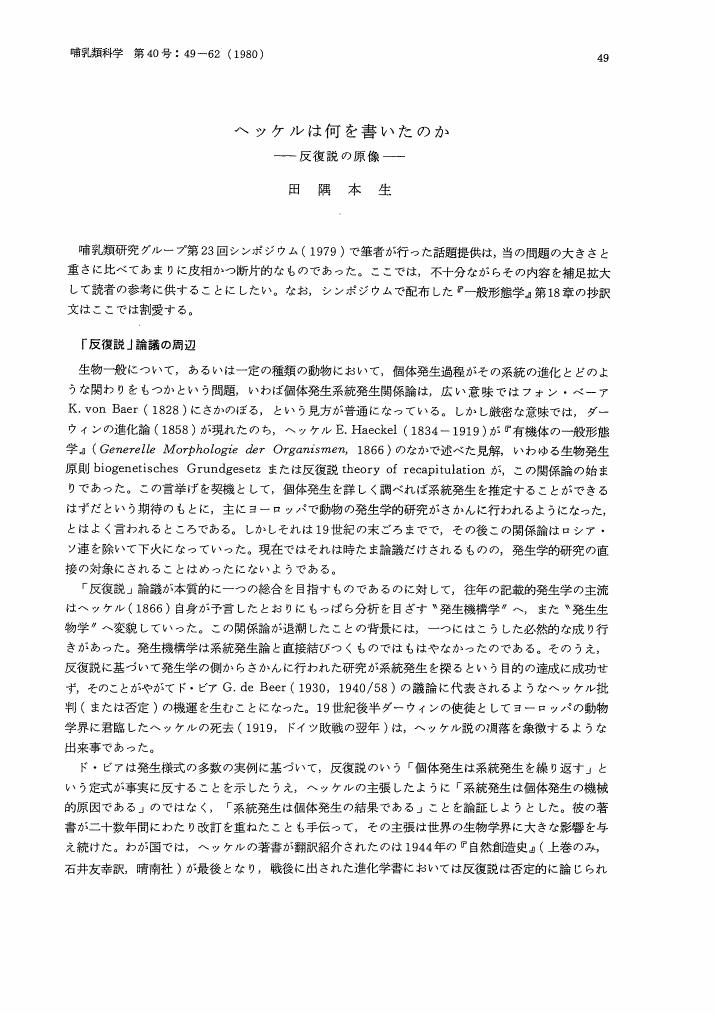5 0 0 0 OA 哺乳類の日本語分類群名,特に目名の取扱いについて —文部省の“目安”にどう対応するか—
- 著者
- 田隅 本生
- 出版者
- 日本哺乳類学会
- 雑誌
- 哺乳類科学 (ISSN:0385437X)
- 巻号頁・発行日
- vol.40, no.1, pp.83-99, 2000 (Released:2008-07-30)
- 被引用文献数
- 3
3 0 0 0 OA ヘッケルは何を書いたのか—反復説の原像—
- 著者
- 田隅 本生
- 出版者
- 日本哺乳類学会
- 雑誌
- 哺乳類科学 (ISSN:0385437X)
- 巻号頁・発行日
- vol.20, no.1, pp.1_49-62, 1980 (Released:2008-10-01)
2 0 0 0 OA 形態学の貧困は克服されるか ポルトマン『背椎動物比較形態学』発刊に寄せて
- 著者
- 田隅 本生
- 出版者
- 日本哺乳類学会
- 雑誌
- 哺乳類科学 (ISSN:0385437X)
- 巻号頁・発行日
- vol.19, no.3, pp.3_53-56, 1979 (Released:2008-12-17)
1 0 0 0 OA 脊椎動物における鼻器の進化と多様性
- 著者
- 田隅 本生
- 出版者
- 耳鼻咽喉科展望会
- 雑誌
- 耳鼻咽喉科展望 (ISSN:03869687)
- 巻号頁・発行日
- vol.14, no.1, pp.9-16,2, 1971-02-15 (Released:2011-08-10)
- 参考文献数
- 12
The evolutionary process in which diverse nasal organs of the vertebrates have developed and come into existence is surveyed from the view-point of paleontology and comparative anatomy.The nasal organ first appeared as a single common opening of the olfactory apparatus and hypophysis (naso-hypophysial opening) in the Paleozoic ostracoderms. During the course of fifish evolution, it developed and settled into paried nasal pits furnished with anterior and posterior nares. In the stage of transition from a certain advanced line of the bony fish to the first amphibians, the nasal pit became the meatus for air breathing by the perforation of a third naris (choana) at the bottom of each nasal pit. Thus the olfaction was made more effective, and the basis of vertebrate adaptation to life on the land was established. In a stage of reptilian evolution Jacobson's organ as an accessory olfactory apparatus was developed, and the nasal meatus became more complete with partial formation of the nasal conchae and secondary palate. Finally, on the transition from mammal-like reptiles to mammals in the Mesozoic period, the nasal cavity was separated from the oral cavity through the completion of the secondary palate, with a result that the efficiency of air breathing, feeding, and vacalization has been increased. In mammals the nasal conchae and paranasal sinuses are also highly developed.In spite of the extensive knowledge on the nasal organs of extinct and living vertebrates, there are many questions left unsolved, such as the actual origin of the internal naris and the function of the paranasal sinuses. The whole aspect of the vertebrate nasal organs will not be obtained until these problems have been elucidated.
- 著者
- 田隅 本生
- 出版者
- 日本哺乳類学会
- 雑誌
- 哺乳類科学 = Mammalian Science (ISSN:0385437X)
- 巻号頁・発行日
- vol.40, no.1, pp.83-99, 2000-06-30
- 参考文献数
- 32
- 被引用文献数
- 4


